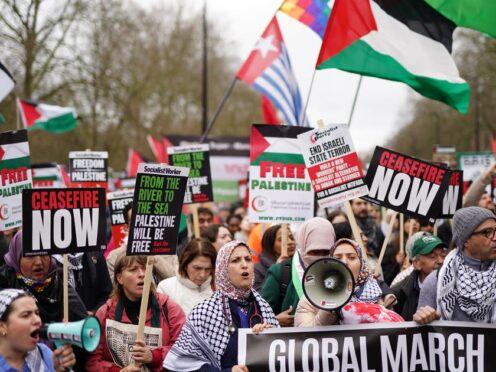
The Home Office has been urged to consider requiring protest organisers to give police more notice of demonstrations if they continue to take place at the frequency and scale of those over the conflict in the Middle East.
The recommendation was one of the key findings of a Home Affairs Committee (HAC) report on policing protests, which found demonstrations, and the “disruptive tactics” of some participants, are causing “unsustainable pressure” on policing resources.
According to the report, policing the protests between October 7 and December 17 last year cost forces across the UK more than £25 million.

It cost the Metropolitan Police an estimated £18.9 million and other police forces a collective £6.5 million, from the same date to December 10.
More than 4,000 rest days for officers have been cancelled to ensure protests could be policed safely, the report added.
Protest groups have criticised the report, with a spokesman for the Campaign Against Antisemitism (CAA) saying it fails to address the need to “ensure the safety of this country’s Jewish community”.
The cross-party committee called for police forces to be given greater support to deal with protests, citing that representatives from the Metropolitan Police said policing demonstrations over the Middle East conflict has led to “the greatest period of sustained pressure on the Met since the Olympics in 2012”.
The report said: “Should these protests continue indefinitely, it stands to reason that forces will be less able to carry out the everyday neighbourhood and response policing that is so vital to the public.
“If the protests continue to take place as frequently at this scale, the Home Office should consider amending requirements for protest organisers, such as increasing the notice period for protest organisers to inform the police from the current six days, to allow the police to prepare better.”

The HAC labelled it “worrying” that the Government’s plan to tackle hate crime has not been updated since 2020, referencing the rise in reported hate crimes and reported terrorist offences since the Hamas attacks of October 7.
It concluded the Government “must” set out a date in its response to the report by which it will publish an updated strategy.
HAC chairwoman Dame Diana Johnson said: “It is deeply dispiriting to see the fight against hate crime get stuck in Home Office limbo.”
She added: “We need to see much more action from the Home Office, both in how it reacts to the constructive advice it receives and how it develops strategy.
The committee also expressed concern over protests outside the homes and offices of MPs – an issue which reared its head last week following a chaotic debate on the Israel-Hamas war.
“Whilst we respect the right to protest, we are clear that no one, including elected representatives, their families, and their staff, should be made to feel unsafe by protest activity outside their home,” the HAC said.
“Likewise, no one should be intimidated when they are coming and going from their place of work.”
It comes as shadow international development minister Lisa Nandy said on Sunday that she thought “many MPs” will have been in touch with the Speaker to express “concerns about their safety” in recent weeks.
Her comments followed those made by the UK Government’s adviser on political violence and disruption, Baron Walney, who said police should have powers to disperse protests around Parliament, MPs’ offices and council chambers that they deem to be threatening.
Responding to the report, a CAA spokesman said: “Disappointingly, this report fails to address the increasingly urgent need to restore the confidence of the British public and ensure the safety of this country’s Jewish community.
“The committee has rightly acknowledged the immediate and severe threat posed to their MP colleagues by intimidation and violent attacks but, despite having extensively quoted our evidence in their report, they do not appear to have treated the threat to the Jewish community with the same degree of alarm.
“Staggeringly, it appears that the only concrete recommendation from the committee in relation to the protests is that the organisers should give more notice to the police, which would not change the actual nature of these marches and therefore solves nothing other than timesheet planning for our overstretched police forces.”
They added: “After months of intimidatory marches, this report offers no concrete recommendations for the here and now, just a long-term policy discussion about workforce planning and new laws that will take years to agree.
“Millions of pounds are being diverted from fighting crime into policing these relentless marches. The Jewish community is in fear and our city centres remain no-go zones during the protests. We need action urgently.”
Graham Smith, chief executive of pressure group Republic which calls for an elected head of state, said: “The onus is on the police to ensure they can handle protests properly, it is not the responsibility of protesters to assist them in that role in such a way that obstructs the right to protest.
“Further regulation on protest will only mean further restriction on protest. The answer is a better resourced, better trained police – and genuine accountability for officers who unlawfully arrest or harass protesters.”
The HAC also called for the effectiveness of new powers available to police under the Public Order Act 2023 to be scrutinised and for the Government to set out a 10-year “workforce plan” for policing to replace the current system of individual plans for each police force.
The Home Office has been contacted for comment.

Enjoy the convenience of having The Sunday Post delivered as a digital ePaper straight to your smartphone, tablet or computer.
Subscribe for only £5.49 a month and enjoy all the benefits of the printed paper as a digital replica.
Subscribe